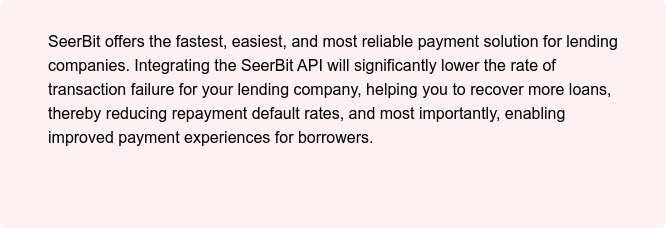How payment technology can help loan companies increase recovery rates
These days, the speed of digital transformation creates new and exciting opportunities for lending companies. Digital technologies have transformed the lending industry, making it easier for borrowers to access credit financing options while reducing customer acquisition costs and increasing the operational efficiency of the company. Some other benefits of digital transformation in the lending industry include:
- Automating processes, such as credit checking and identity verification, and using algorithms to make more informed lending decisions.
- Making it easy for borrowers, especially those with limited access to traditional financial institutions, to apply for loans from their homes without the need to visit a physical branch.
- Enabling lenders to offer more personalized and flexible lending options to their customers like Buy Now Pay Later
However, with so many credit financing options available, loan recovery processes have become a headache for lending operation teams. This article explores how loan companies can leverage payment technology to reduce loan recovery friction.
State of loan recovery in Nigeria
Loan recovery is a big challenge in the lending industry as the process can be impacted by a lot of factors like the specific business model of the loan company, the types of loans being offered, as well as other external factors like the overall economic conditions in the country and changes in regulatory environments.
According to the IMF, NPL ratios have significantly increased in most SSA countries post-COVID-19 pandemic as economic restrictions and other disruptions resulted in households defaulting on loan repayments.
How to Increase Loan recovery rates with payment technology
Lenders must seize every chance to raise their margins because loan recovery is a margin-based game. Let's talk about a few ways that loan companies can improve their loan recovery rates to achieve higher margins.
Improved qualification systems
The quality of borrowers is an important factor in determining the likelihood of repayment of a loan. That’s why it is important to properly assess the creditworthiness of borrowers before extending them a loan. The more data points about a potential borrower a lender has the better-informed decision about whether to extend a loan and under what terms, a lender can make.
This is why it's crucial for lenders to invest in and utilize credit-scoring technology platforms that can give them access to the borrower's employment history, savings, debt-to-income ratio, and other alternative credit scoring models like rental or utility bill payment histories to develop a more thorough and effective qualification system.
However, it's important to note that having more data is not enough to guarantee a better decision. The data must be analyzed carefully and used in conjunction with other factors, such as the lender's risk tolerance and the terms of the loan, to make an informed decision.
Integrate an efficient payment gateway
Simplifying the loan repayment process is a significant benefit of utilizing a reliable payment gateway. In order to make it simple for borrowers to make loan repayments from any location, at any time, loan companies need to have effective repayment and disbursement services.
A loan company may experience a high rate of failed transactions as a result of an inefficient payment gateway, which could have a negative impact on the business's bottom line because it will take more time and money to resolve the issues caused by these failed transactions.
Failed transactions can also result in a loss of revenue because customers who are having trouble making their payments might abandon the transaction. Fraudsters can also take advantage of these technical issues to defraud the company, resulting in high chargeback requests.
SeerBit offers an efficient payment gateway that improves the overall efficiency of the lending process. Our proprietary payment engine ensures stability by re-routing payments in case a processor goes down and secures revenue with automated retries. This helps loan companies easily track and manage loan repayments from their borrowers, and disbursements, as well as ensure that failed transactions are kept to a minimum
Implement Partial Debit
In some cases, customers might not have the full pre-agreed amount to be debited from their bank account, which would result in a declined transaction, this is where the SeerBit partial debit feature would come in handy to help loan companies to recover outstanding loans in a timely manner.
With SeerBit’s partial debit feature, loan companies can charge their customers up to 90% of the amount that is available in their bank accounts, allowing them to make partial payments towards their outstanding loans rather than having to wait until the full amount due is available in their bank accounts.
The partial debit feature is a convenient and flexible option for borrowers that lowers the risk of default and encourages borrowers to continue making timely payments on their outstanding loans while helping loan companies in Nigeria increase collection rates and improve recovery margins
Conclusion
In the fast-paced and constantly evolving world of finance, loan companies in Nigeria must constantly adopt digital technologies that allow them to assess and optimize their loan recovery processes in order to improve their financial performance, stay ahead of the curve, and better meet the needs of their customers.


